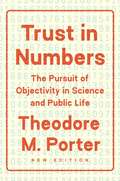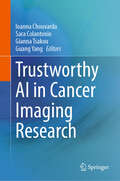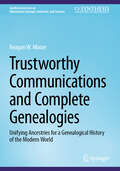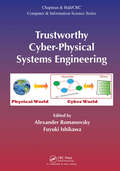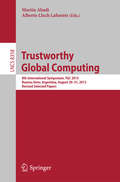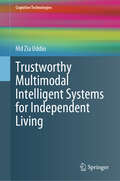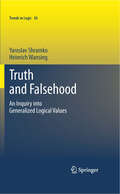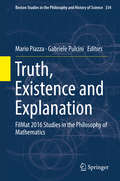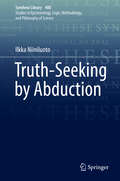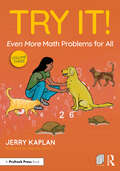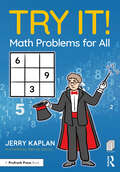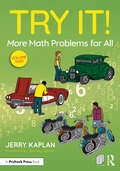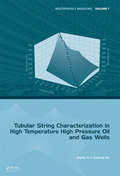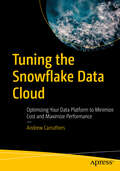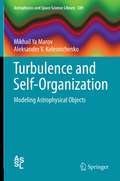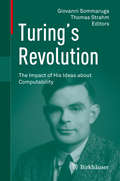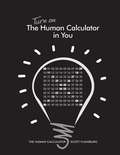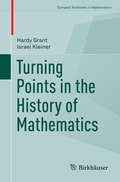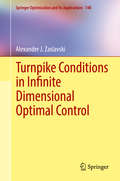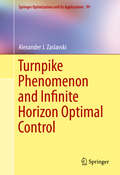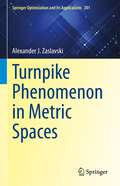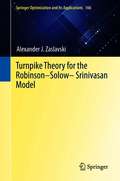- Table View
- List View
Trust in Numbers: The Pursuit of Objectivity in Science and Public Life
by Theodore M. PorterA foundational work on historical and social studies of quantificationWhat accounts for the prestige of quantitative methods? The usual answer is that quantification is desirable in social investigation as a result of its successes in science. Trust in Numbers questions whether such success in the study of stars, molecules, or cells should be an attractive model for research on human societies, and examines why the natural sciences are highly quantitative in the first place. Theodore Porter argues that a better understanding of the attractions of quantification in business, government, and social research brings a fresh perspective to its role in psychology, physics, and medicine. Quantitative rigor is not inherent in science but arises from political and social pressures, and objectivity derives its impetus from cultural contexts. In a new preface, the author sheds light on the current infatuation with quantitative methods, particularly at the intersection of science and bureaucracy.
Trustworthy AI in Cancer Imaging Research
by Ioanna Chouvarda Guang Yang Sara Colantonio Gianna TsakouThe book covers multiple aspects and challenges, from legal to technical and validation, in the emerging topic of AI in cancer imaging, bringing together the experience of top researchers and flagship projects. The aim of this book is to address the important questions: &“How to design AI that is trustworthy&”, and &“How to validate AI trustworthiness&” in the scope of AI for cancer imaging research. The book discusses overall considerations and the generation of a framework; preparing for trustworthy AI, including the data and metadata for quality, transparency and traceability; implementing trustworthy AI with algorithms and Decision Support Systems; and validating trustworthy AI. This is an ideal resource for researchers from technical and clinical research sites, postgraduate students, and healthcare professionals in cancer imaging and beyond.
Trustworthy Artificial Intelligence for Healthcare: Second International Workshop, TAI4H 2024, Jeju, South Korea, August 4, 2024, Proceedings (Lecture Notes in Computer Science #14812)
by Daguang Xu Hao Chen Yuyin Zhou Varut Vince VardhanabhutiThis book constitutes the proceedings of Second International Workshop on Trustworthy Artificial Intelligence for Healthcare, TAI4H 2024, held in Jeju, South Korea, in August 2024, in conjunction with the International Joint Conference on Artificial Intelligence, IJCAI 2024. The 13 full papers included in this book were carefully reviewed and selected from 21 submissions. They focus on trustworthy artificial intelligence, healthcare, generalization, explainability, fairness, privacy, multi-modal fusion, foundation models.
Trustworthy Communications and Complete Genealogies: Unifying Ancestries for a Genealogical History of the Modern World (Synthesis Lectures on Information Concepts, Retrieval, and Services)
by Reagan W. MooreThis book explains how all persons with Western European ancestry are related through a Unifying Ancestry. The author presents the knowledge metrics needed to derive the best representation for a Unifying Ancestry. The book uses example lineages to historically notable persons including relationships to U.S. Presidents, royal families, actors, and singers in order to demonstrate these points. This third edition is based upon expanded data, applying the algorithms to validate the Unifying Ancestry to a 348,844-person Research Genealogy. The author successfully demonstrates that a Unifying Ancestry with 38,533 persons is sufficient to identify familial relationships between Western Europeans.
Trustworthy Cyber-Physical Systems Engineering (Chapman & Hall/CRC Computer and Information Science Series #36)
by Fuyuki Ishikawa Alexander RomanovskyFrom the Foreword "Getting CPS dependability right is essential to forming a solid foundation for a world that increasingly depends on such systems. This book represents the cutting edge of what we know about rigorous ways to ensure that our CPS designs are trustworthy. I recommend it to anyone who wants to get a deep look at these concepts that will form a cornerstone for future CPS designs." --Phil Koopman, Carnegie Mellon University, Pittsburgh, Pennsylvania, USA Trustworthy Cyber-Physical Systems Engineering provides practitioners and researchers with a comprehensive introduction to the area of trustworthy Cyber Physical Systems (CPS) engineering. Topics in this book cover questions such as What does having a trustworthy CPS actually mean for something as pervasive as a global-scale CPS? How does CPS trustworthiness map onto existing knowledge, and where do we need to know more? How can we mathematically prove timeliness, correctness, and other essential properties for systems that may be adaptive and even self-healing? How can we better represent the physical reality underlying real-world numeric quantities in the computing system? How can we establish, reason about, and ensure trust between CPS components that are designed, installed, maintained, and operated by different organizations, and which may never have really been intended to work together? Featuring contributions from leading international experts, the book contains sixteen self-contained chapters that analyze the challenges in developing trustworthy CPS, and identify important issues in developing engineering methods for CPS. The book addresses various issues contributing to trustworthiness complemented by contributions on TCSP roadmapping, taxonomy, and standardization, as well as experience in deploying advanced system engineering methods in industry. Specific approaches to ensuring trustworthiness, namely, proof and refinement, are covered, as well as engineering methods for dealing with hybrid aspects.
Trustworthy Global Computing: 8th International Symposium, TGC 2013, Buenos Aires, Argentina, August 30-31, 2013, Revised Selected Papers (Lecture Notes in Computer Science #8358)
by Martín Abadi and Alberto Lluch LafuenteThis book constitutes the thoroughly refereed post-conference proceedings of the 8th International Symposium on Trustworthy Global Computing, TGC 2013, held in Buenos Aires, Argentina, in August 2013. The 15 revised full papers presented together with 3 invited talks were carefully reviewed and selected from 29 submissions. The papers cover a wide range of topics in the area of global computing and safe and reliable computation. They are organized in topical sections on security, π-calculus, information flow, models, specifications and proofs and quantitative analysis.
Trustworthy Multimodal Intelligent Systems for Independent Living (Cognitive Technologies)
by Md Zia UddinThis book is an essential guide for anyone interested in how artificial intelligence can enhance the quality of life for individuals who wish to maintain autonomy in their own homes. The author begins by introducing the reader to AI applications in independent living environments, such as smart assisted homes and AI-driven personalization, and thoughtfully explores the ethical challenges involved. With a strong focus on the intersection of technology and human needs, the book provides a detailed roadmap for building intelligent systems that promote safety, independence, and dignity, especially for elderly or vulnerable populations. The author offers both foundational knowledge and critical discussions around the opportunities and limitations of AI when applied to daily life scenarios. A major strength of the book lies in its thorough examination of multimodal systems. Readers are introduced to a rich array of sensor technologies including wearable devices, environmental sensors, vision-based systems, and sound-based inputs. These components are described not only in terms of their individual functionalities but also in how they interact and fuse data to support complex inference tasks. The text walks the reader through system architectures—centralized and distributed—while emphasizing data fusion, synchronization, and real-time versus batch processing. Through practical examples such as fall detection alerts and activity recognition, the book highlights the engineering challenges and solutions involved in building robust, responsive, and user-accepted assistive systems. Ethical deployment, user engagement, long-term maintenance, and family involvement are all addressed in ways that reflect real-world concerns and user diversity. The book also tackles some of the most pressing topics in AI today: data privacy, explainability, and trust. With an entire section dedicated to synthetic data, it explains how artificial data can be used to train effective models while safeguarding user privacy.
Truth Decay: An Initial Exploration of the Diminishing Role of Facts and Analysis in American Public Life
by Michael D. Rich KavanaghPolitical and civil discourse in the United States is characterized by “Truth Decay,” defined as increasing disagreement about facts, a blurring of the line between opinion and fact, an increase in the relative volume of opinion compared with fact, and lowered trust in formerly respected sources of factual information. This report explores the causes and wide-ranging consequences of Truth Decay and proposes strategies for further action.
Truth and Falsehood
by Heinrich Wansing Yaroslav ShramkoThe book presents a thoroughly elaborated logical theory of generalized truth-values understood as subsets of some established set of (basic) truth values. After elucidating the importance of the very notion of a truth value in logic and philosophy, we examine some possible ways of generalizing this notion. The useful four-valued logic of first-degree entailment by Nuel Belnap and the notion of a bilattice (a lattice of truth values with two ordering relations) constitute the basis for further generalizations. By doing so we elaborate the idea of a multilattice, and most notably, a trilattice of truth values - a specific algebraic structure with information ordering and two distinct logical orderings, one for truth and another for falsity. Each logical order not only induces its own logical vocabulary, but determines also its own entailment relation. We consider both semantic and syntactic ways of formalizing these relations and construct various logical calculi.
Truth or Beauty
by David OrrellFor millennia, scientists and philosophers have strived to show that the universe is governed by a few simple principles. These principles are not derived from science. They do not come from looking through telescopes or carefully examining the results generated by particle colliders. Rather,they are based on aesthetic laws and concepts such as symmetry, beauty, and unity. Scientist and author David Orrell considers how aesthetics have influenced the models we create in hopes of explaining our universe. His book begins with a look at early scientific thinkers, from the ancient Greeks to Galileo. The ancients constructed a concept of the world based on musical harmony;later thinkers overturned this concept, but replaced it with a program, based on Newton's "rational mechanics," to reduce the universe to a few simple equations. Orrell then turns to the scientific program of the twentieth century, culminating in supersymmetric string theory, which was againinfluenced by deep aesthetic principles. In a final section of the book, Orrell broadens his discussion to other fields of research, including economics, architecture, and health. Recent history has shown us what happens when financiers rely on a model of economics that resembles what a good theory"should look like" rather than the messy reality of human interaction. Ideas of mathematical elegance have inspired, entranced, and "sometimes misled" thinkers in their desire to find the laws that govern our universe. Orrell evaluates these aesthetic principles as a means of understanding the structure of the universe - let alone messy human society - and questionswhether they reflect an accurate way to understand our world. Truth or Beauty comes at an interesting period, when the multi-billion-dollar Large Hadron Collider in Switzerland has been designed to test the existence of exotic phenomena such as supersymmetric particles. Will these too turn out to be nothing more than a beautiful illusion?
Truth, Existence and Explanation: FilMat 2016 Studies in the Philosophy of Mathematics (Boston Studies in the Philosophy and History of Science #334)
by Mario Piazza Gabriele PulciniThis book contains more than 15 essays that explore issues in truth, existence, and explanation. It features cutting-edge research in the philosophy of mathematics and logic.Renowned philosophers, mathematicians, and younger scholars provide an insightful contribution to the lively debate in this interdisciplinary field of inquiry. The essays look at realism vs. anti-realism as well as inflationary vs. deflationary theories of truth. The contributors also consider mathematical fictionalism, structuralism, the nature and role of axioms, constructive existence, and generality. In addition, coverage also looks at the explanatory role of mathematics and the philosophical relevance of mathematical explanation.The book will appeal to a broad mathematical and philosophical audience. It contains work from FilMat, the Italian Network for the Philosophy of Mathematics. These papers collected here were also presented at their second international conference, held at the University of Chieti-Pescara, May 2016.
Truth-Seeking by Abduction (Synthese Library #400)
by Ilkka NiiniluotoThis book examines the philosophical conception of abductive reasoning as developed by Charles S. Peirce, the founder of American pragmatism. It explores the historical and systematic connections of Peirce's original ideas and debates about their interpretations. Abduction is understood in a broad sense which covers the discovery and pursuit of hypotheses and inference to the best explanation. The analysis presents fresh insights into this notion of reasoning, which derives from effects to causes or from surprising observations to explanatory theories.The author outlines some logical and AI approaches to abduction as well as studies various kinds of inverse problems in astronomy, physics, medicine, biology, and human sciences to provide examples of retroductions and abductions. The discussion covers also everyday examples with the implication of this notion in detective stories, one of Peirce’s own favorite themes.The author uses Bayesian probabilities to argue that explanatory abduction is a method of confirmation. He uses his own account of truth approximation to reformulate abduction as inference which leads to the truthlikeness of its conclusion. This allows a powerful abductive defense of scientific realism. This up-to-date survey and defense of the Peircean view of abduction may very well help researchers, students, and philosophers better understand the logic of truth-seeking.
Try It! Even More Math Problems for All
by Jerry KaplanThis is not your typical math book.Try It! Even More Math Problems for All is the third of three collections of offbeat, open-ended problems designed to make even the most math-averse student excited about working through these challenging yet accessible problems.The Hints and Solutions section guides you to probe, suggest, and encourage students to explore even their most unusual insights on the way to solving these 25 new, illustrated problems of varying difficulty. As a result, you will be able to motivate your students to think creatively on their own and to engage in teamwork. And when students solve a problem, you will see and hear their accomplishments.Perfect for any math classroom, club, after school activity, or coaching session, Try It! celebrates not only the destination, but the journey, giving students a chance to think differently, and, above all, have fun!Can’t get enough? Volume 1 in the series, Try It! Math Problems for All, and Volume 2, Try It! More Math Problems for All, are also available at Routledge.com.Optional Student Workbook PacksIn addition to this teachers' guide, companion student workbooks are available in packs of ten. The student workbooks feature ample room for student responses and notes, make reviewing and providing feedback on student work easy, provide students with a quick reference to use during discussions, and they save time — there is no need to reproduce student handouts.
Try It! Math Problems for All
by Jerry KaplanThis is not your typical math book. Breaking away from the standard drill and practice routine, Try It! Math Problems for All is a collection of offbeat, open-ended math problems designed to make even the most math-averse student excited about working through these challenging yet accessible problems. The 25 illustrated problems vary in difficulty, motivating students to think creatively on their own, or to engage in teamwork and cooperation within a group, while the Hints and Solutions section guides teachers to probe, suggest, and encourage students to explore even their most unusual insights on the way to a solution. Perfect for any math classroom, club, after-school activity, or coaching session, Try It! celebrates not only the destination, but the journey, giving students a chance to relax, think differently, and, above all, have fun! Optional Student Workbook Packs In addition to this teacher's guide, companion student workbooks are available in packs of ten. The student workbooks feature ample room for student responses and notes, make reviewing and providing feedback on student work easier than ever, provide students with an easy-to-use reference to use during discussions, and save time, as there is no need to reproduce student handouts.
Try It! More Math Problems for All
by Jerry KaplanThis is not your typical math book. Try It! More Math Problems for All is the second of three collections of offbeat, open-ended problems designed to make even the most math-averse student excited about working through these challenging yet accessible problems. These are 25 new, illustrated problems varying in difficulty. They will motivate your students to think creatively on their own and to engage in teamwork. The Hints and Solutions section guides you to probe, suggest, and encourage students to explore even their most unusual insights on the way to a solution. And when students solve a problem, you will see and hear their accomplishments. Perfect for any math classroom, club, after school activity, or coaching session, Try It! celebrates not only the destination, but the journey, giving students a chance to think differently, and, above all, have fun! Can’t get enough? Volumes 1 and 3 in the series are also available at Routledge.com. Optional Student Workbook Packs In addition to this teachers' guide, companion student workbooks are available in packs of ten. The student workbooks feature ample room for student responses and notes, make reviewing and providing feedback on student work easy, provide students with a quick reference to use during discussions, and they save time — there is no need to reproduce student handouts.
Tubular String Characterization in High Temperature High Pressure Oil and Gas Wells (Multiphysics Modeling)
by Jiuping Xu Zezhong WuHigh temperature, high oil pressure, oil and gas well completion testing have always been a technical challenge and basic theoretical research is one of the key factors needed to ensure a successful completion test. The completion test basic theory includes: a stress analysis of the completion string, completion string buckling behavior, and temperature and pressure distribution prediction. The completion string is the main bearing and power transmission component for oil and gas well operations and production, and it is required to take on a combination of loads, which result in completion string deformation. Because of these complex relationships, completion string stress analysis has become increasingly more complicated.This book discusses the characters of tubular strings in HTHP (High Temperature - High Pressure) oil and gas wells. These characters include the mechanical behavior of tubular strings and the temperature and pressure variation of tubular strings in different conditions. Mathematical models are established for different conditions and solution existence and uniqueness of some models is discussed, providing algorithms corresponding to the different models. Numerical experiments are presented to verify the validity of models and the feasibility of algorithms, and the impact of the parameters of models for oil and gas wells is also discussed.This book is written for production and testing engineers to provide them with the tools to deal more effectively with the numerical decisions they have to take and for researchers and technicians in petroleum and gas testing and production engineering. Finally, it is also intended to serve as a reference book for mathematicians, college teachers and students.
Tuning the Snowflake Data Cloud: Optimizing Your Data Platform to Minimize Cost and Maximize Performance
by Andrew CarruthersThis project-oriented book presents a hands-on approach to identifying migration and performance issues with experience drawn from real-world examples. As you work through the book, you will develop skills, knowledge, and deep understanding of Snowflake tuning options and capabilities while preparing for later incorporation of additional Snowflake features as they become available. Your Snowflake platform will cost less to run and will improve your customer experience. Written by a seasoned Snowflake practitioner, this book is full of practical, hands-on guidance and advice specifically designed to further accelerate your Snowflake journey. Tuning the Snowflake Data Cloud provides you a pathway to success by equipping you with the skills, knowledge, and expertise needed to elevate your Snowflake experience. The book shows you how to leverage what you already know, adds what you don’t, and helps you apply it toward delivering for your Snowflake accounts. Read this book to embark on a voyage of advancement and equip your organization to deliver consistent Snowflake performance. What You Will Learn Recognize and understand the root cause of performance bottlenecks Know how to resolve performance issues Develop a deep understanding of Snowflake performance tuning options Reduce expensive mistakes, remediate poorly performing code Manage Snowflake costs
Turbulence and Self-Organization
by Mikhail Ya Marov Aleksander V. KolesnichenkoThe book deals with the development of continual models of turbulent natural media. Such models serve as a ground for the statement and numerical evaluation of the key problems of the structure and evolution of the numerous astrophysical and geophysical objects. The processes of ordering (self-organization) in an originally chaotic turbulent medium are addressed and treated in detail with the use of irreversible thermodynamics and stochastic dynamics approaches which underlie the respective models. Different examples of ordering set up in the natural environment and outer space are brought and thoroughly discussed, the main focus being given to the protoplanetary discs formation and evolution.
Turing’s Revolution: The Impact of His Ideas about Computability
by Giovanni Sommaruga Thomas StrahmThis book provides an overview of the confluence of ideas in Turing’s era and work and examines the impact of his work on mathematical logic and theoretical computer science. It combines contributions by well-known scientists on the history and philosophy of computability theory as well as on generalised Turing computability. By looking at the roots and at the philosophical and technical influence of Turing’s work, it is possible to gather new perspectives and new research topics which might be considered as a continuation of Turing’s working ideas well into the 21st century.The Stored-Program Universal Computer: Did Zuse Anticipate Turing and von Neumann?” is available open access under a Creative Commons Attribution 4.0 International License via link.springer.com
Turn on The Human Calculator in You: The Human Calculator
by Scott FlansburgThis workbook, along with the separately-sold "Answer Guide," will introduce you to all the basic arithmetic facts using The Human Calculator Matrix. Discover all the patterns that will make you feel like a mathlete and a human calculator.
Turning Points in the History of Mathematics
by Hardy Grant Israel KleinerThis book explores some of the major turning points in the history of mathematics, ranging from ancient Greece to the present, demonstrating the drama that has often been a part of its evolution. Studying these breakthroughs, transitions, and revolutions, their stumbling-blocks and their triumphs, can help illuminate the importance of the history of mathematics for its teaching, learning, and appreciation. Some of the turning points considered are the rise of the axiomatic method (most famously in Euclid), and the subsequent major changes in it (for example, by David Hilbert); the "wedding," via analytic geometry, of algebra and geometry; the "taming" of the infinitely small and the infinitely lar≥ the passages from algebra to algebras, from geometry to geometries, and from arithmetic to arithmetics; and the revolutions in the late nineteenth and early twentieth centuries that resulted from Georg Cantor's creation of transfinite set theory. The origin of each turning point is discussed, along with the mathematicians involved and some of the mathematics that resulted. Problems and projects are included in each chapter to extend and increase understanding of the material. Substantial reference lists are also provided. Turning Points in the History of Mathematics will be a valuable resource for teachers of, and students in, courses in mathematics or its history. The book should also be of interest to anyone with a background in mathematics who wishes to learn more about the important moments in its development.
Turnpike Conditions in Infinite Dimensional Optimal Control (Springer Optimization and Its Applications #148)
by Alexander J. ZaslavskiThis book provides a comprehensive study of turnpike phenomenon arising in optimal control theory. The focus is on individual (non-generic) turnpike results which are both mathematically significant and have numerous applications in engineering and economic theory. All results obtained in the book are new. New approaches, techniques, and methods are rigorously presented and utilize research from finite-dimensional variational problems and discrete-time optimal control problems to find the necessary conditions for the turnpike phenomenon in infinite dimensional spaces. The semigroup approach is employed in the discussion as well as PDE descriptions of continuous-time dynamics. The main results on sufficient and necessary conditions for the turnpike property are completely proved and the numerous illustrative examples support the material for the broad spectrum of experts. Mathematicians interested in the calculus of variations, optimal control and in applied functional analysis will find this book a useful guide to the turnpike phenomenon in infinite dimensional spaces. Experts in economic and engineering modeling as well as graduate students will also benefit from the developed techniques and obtained results.
Turnpike Phenomenon and Infinite Horizon Optimal Control
by Alexander J. ZaslavskiThis book is devoted to the study of the turnpike phenomenon and describes the existence of solutions for a large variety of infinite horizon optimal control classes of problems. Chapter 1 provides introductory material on turnpike properties. Chapter 2 studies the turnpike phenomenon for discrete-time optimal control problems. The turnpike properties of autonomous problems with extended-value integrands are studied in Chapter 3. Chapter 4 focuses on large classes of infinite horizon optimal control problems without convexity (concavity) assumptions. In Chapter 5, the turnpike results for a class of dynamic discrete-time two-player zero-sum game are proven. This thorough exposition will be very useful for mathematicians working in the fields of optimal control, the calculus of variations, applied functional analysis and infinite horizon optimization. It may also be used as a primary text in a graduate course in optimal control or as supplementary text for a variety of courses in other disciplines. Researchers in other fields such as economics and game theory, where turnpike properties are well known, will also find this Work valuable.
Turnpike Phenomenon in Metric Spaces (Springer Optimization and Its Applications #201)
by Alexander J. ZaslavskiThis book is devoted to the study of the turnpike phenomenon arising in optimal control theory. Special focus is placed on Turnpike results, in sufficient and necessary conditions for the turnpike phenomenon and in its stability under small perturbations of objective functions. The most important feature of this book is that it develops a large, general class of optimal control problems in metric space. Additional value is in the provision of solutions to a number of difficult and interesting problems in optimal control theory in metric spaces. Mathematicians working in optimal control, optimization, and experts in applications of optimal control to economics and engineering, will find this book particularly useful.All main results obtained in the book are new. The monograph contains nine chapters. Chapter 1 is an introduction. Chapter 2 discusses Banach space valued functions, set-valued mappings in infinite dimensional spaces, and related continuous-time dynamical systems. Some convergence results are obtained. In Chapter 3, a discrete-time dynamical system with a Lyapunov function in a metric space induced by a set-valued mapping, is studied. Chapter 4 is devoted to the study of a class of continuous-time dynamical systems, an analog of the class of discrete-time dynamical systems considered in Chapter 3. Chapter 5 develops a turnpike theory for a class of general dynamical systems in a metric space with a Lyapunov function. Chapter 6 contains a study of the turnpike phenomenon for discrete-time nonautonomous problems on subintervals of half-axis in metric spaces, which are not necessarily compact. Chapter 7 contains preliminaries which are needed in order to study turnpike properties of infinite-dimensional optimal control problems. In Chapter 8, sufficient and necessary conditions for the turnpike phenomenon for continuous-time optimal control problems on subintervals of the half-axis in metric spaces, is established. In Chapter 9, the examination continues of the turnpike phenomenon for the continuous-time optimal control problems on subintervals of half-axis in metric spaces discussed in Chapter 8.
Turnpike Theory for the Robinson–Solow–Srinivasan Model (Springer Optimization and Its Applications #166)
by Alexander J. ZaslavskiThis book is devoted to the study of a class of optimal control problems arising in mathematical economics, related to the Robinson–Solow–Srinivasan (RSS) model. It will be useful for researches interested in the turnpike theory, infinite horizon optimal control and their applications, and mathematical economists. The RSS is a well-known model of economic dynamics that was introduced in the 1960s and as many other models of economic dynamics, the RSS model is determined by an objective function (a utility function) and a set-valued mapping (a technology map). The set-valued map generates a dynamical system whose trajectories are under consideration and the objective function determines an optimality criterion. The goal is to find optimal trajectories of the dynamical system, using the optimality criterion. Chapter 1 discusses turnpike properties for some classes of discrete time optimal control problems. Chapter 2 present the description of the RSS model and discuss its basic properties. Infinite horizon optimal control problems, related to the RSS model are studied in Chapter 3. Turnpike properties for the RSS model are analyzed in Chapter 4. Chapter 5 studies infinite horizon optimal control problems related to the RSS model with a nonconcave utility function. Chapter 6 focuses on infinite horizon optimal control problems with nonautonomous optimality criterions. Chapter 7 contains turnpike results for a class of discrete-time optimal control problems. Chapter 8 discusses the RSS model and compares different optimality criterions. Chapter 9 is devoted to the study of the turnpike properties for the RSS model. In Chapter 10 the one-dimensional autonomous RSS model is considered and the continuous time RSS model is studied in Chapter 11.
